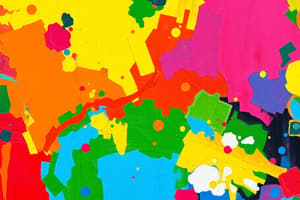Podcast
Questions and Answers
Which primary colors are used in the RGB model of color mixing?
Which primary colors are used in the RGB model of color mixing?
- Cyan, Magenta, and Yellow
- Red, Green, and Blue (correct)
- Green, Blue, and Magenta
- Red, Yellow, and Blue
What is the result of mixing Red and Green light in the RGB model?
What is the result of mixing Red and Green light in the RGB model?
- White
- Yellow (correct)
- Magenta
- Cyan
Which primary colors are used in the CMY model of color mixing?
Which primary colors are used in the CMY model of color mixing?
- Green, Blue, and Magenta
- Red, Yellow, and Blue
- Cyan, Magenta, and Yellow (correct)
- Red, Green, and Blue
What is the result of mixing Cyan and Magenta in the CMY model?
What is the result of mixing Cyan and Magenta in the CMY model?
What is the term for colors created by mixing two primary colors?
What is the term for colors created by mixing two primary colors?
What is the term for colors created by mixing a primary color with a secondary color?
What is the term for colors created by mixing a primary color with a secondary color?
Which model combines light to produce colors?
Which model combines light to produce colors?
What is the result of mixing Red, Green, and Blue light in the RGB model?
What is the result of mixing Red, Green, and Blue light in the RGB model?
Study Notes
Color Mixing
Additive Color Mixing
- Combines light of different colors to produce a new color
- Used in digital displays such as monitors and televisions
- Primary colors: Red, Green, and Blue (RGB)
- Mixing RGB colors in different combinations produces:
- Cyan (Green + Blue)
- Magenta (Red + Blue)
- Yellow (Red + Green)
- White (Red + Green + Blue)
Subtractive Color Mixing
- Combines inks or pigments of different colors to absorb certain wavelengths of light and produce a new color
- Used in printing and painting
- Primary colors: Cyan, Magenta, and Yellow (CMY)
- Mixing CMY colors in different combinations produces:
- Red (Cyan + Magenta)
- Green (Cyan + Yellow)
- Blue (Magenta + Yellow)
- Black (Cyan + Magenta + Yellow)
Color Mixing Models
- RGB Model: used for digital displays, adds light to produce colors
- CMY Model: used for printing and painting, subtracts light to produce colors
- RYB Model: used in traditional art education, a simplified model that combines Red, Yellow, and Blue to produce colors
Key Principles
- Primary Colors: cannot be created by mixing other colors, base colors for mixing
- Secondary Colors: created by mixing two primary colors
- Tertiary Colors: created by mixing a primary color with a secondary color
Color Mixing
Additive Color Mixing
- Combines light of different colors to produce a new color
- Used in digital displays such as monitors and televisions
- Primary colors: Red, Green, and Blue (RGB)
- Mixing RGB colors produces:
- Cyan (Green + Blue)
- Magenta (Red + Blue)
- Yellow (Red + Green)
- White (Red + Green + Blue)
Subtractive Color Mixing
- Combines inks or pigments of different colors to absorb certain wavelengths of light and produce a new color
- Used in printing and painting
- Primary colors: Cyan, Magenta, and Yellow (CMY)
- Mixing CMY colors produces:
- Red (Cyan + Magenta)
- Green (Cyan + Yellow)
- Blue (Magenta + Yellow)
- Black (Cyan + Magenta + Yellow)
Color Mixing Models
- RGB Model: used for digital displays, adds light to produce colors
- CMY Model: used for printing and painting, subtracts light to produce colors
- RYB Model: used in traditional art education, a simplified model that combines Red, Yellow, and Blue to produce colors
Key Principles
- Primary Colors: cannot be created by mixing other colors, base colors for mixing
- Secondary Colors: created by mixing two primary colors
- Tertiary Colors: created by mixing a primary color with a secondary color
Studying That Suits You
Use AI to generate personalized quizzes and flashcards to suit your learning preferences.
Description
This quiz covers the principles of additive and subtractive color mixing, including primary colors, color combinations, and applications in digital displays and printing.



